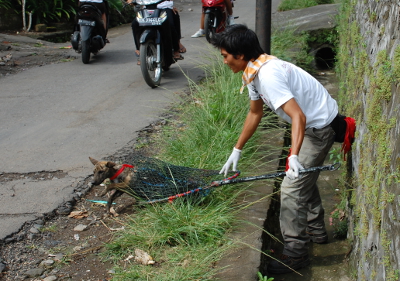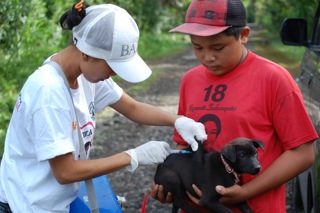Development of life-saving control strategies to eliminate rabies in Bali
Published: 2 July 2014
Our rabies research team played an integral role in the design and ongoing evaluation of canine vaccination programmes to eliminate a rabies epidemic on the island of Bali. These campaigns controlled the spread of rabies in dogs and reduced the incidence of human deaths by over 90% compared with the incidence before the campaigns started.
Our rabies research team played an integral role in the design and ongoing evaluation of canine vaccination programmes to eliminate a rabies epidemic on the island of Bali. These campaigns controlled the spread of rabies in dogs and reduced the incidence of human deaths by over 90% compared with the incidence before the campaigns started.
Rabies is an infectious disease that kills at least 55,000 people annually, primarily in Asia and Africa, with infected dogs being the major source of infection in humans. In a recent rabies epidemic on the Indonesian island of Bali, between Dec 2008 and June 2011 over 130 human deaths occurred because the actions of the local authorities, such as dog culling, were insufficient to control the outbreak.

To advise on this campaign our researchers developed a computer-based model of the Bali epidemic (the Bali model) to predict the potential outcomes of different vaccination strategies. The result of this first campaign was 58 fewer human rabies deaths (a 70% reduction) and 29 fewer reported cases per month in dogs (75% reduction).
When the United Nations Food and Agriculture Organization (FAO) took over rabies control efforts in 2011, the Bali model was used as a technical resource for forward planning and evaluation of subsequent campaigns. As of July 2013, Bali had gone 11 months without a human case of rabies.
Our researchers have also provided significant training to local NGOs and government scientists in surveillance and recording techniques, to ensure that progress towards rabies elimination is carefully monitored.
 The model has also informed a key piece of advocacy for global rabies control by WSPA. Working with the Royal Veterinary College London, the Bali model was used to project the potential economic outcomes of different control strategies. This provides a means by which WSPA can advocate to governments of rabies-endemic countries the cost-benefits of mass vaccination programmes over dog culling.
The model has also informed a key piece of advocacy for global rabies control by WSPA. Working with the Royal Veterinary College London, the Bali model was used to project the potential economic outcomes of different control strategies. This provides a means by which WSPA can advocate to governments of rabies-endemic countries the cost-benefits of mass vaccination programmes over dog culling.
First published: 2 July 2014
<< Wider Impact
Find out more:
- Institute of Biodiversity, Animal Health and Comparative Medicine
- Naturally Speaking podcast - discussing infectious diseases shared by animals and humans
Current staff involved in rabies research:
- Professor Sarah Cleaveland
- Professor Dan Haydon
- Dr Katie Hampson
- Dr Tiziana Lembo
- Dr Daniel Streicker
- Dr Sunny Townsend

